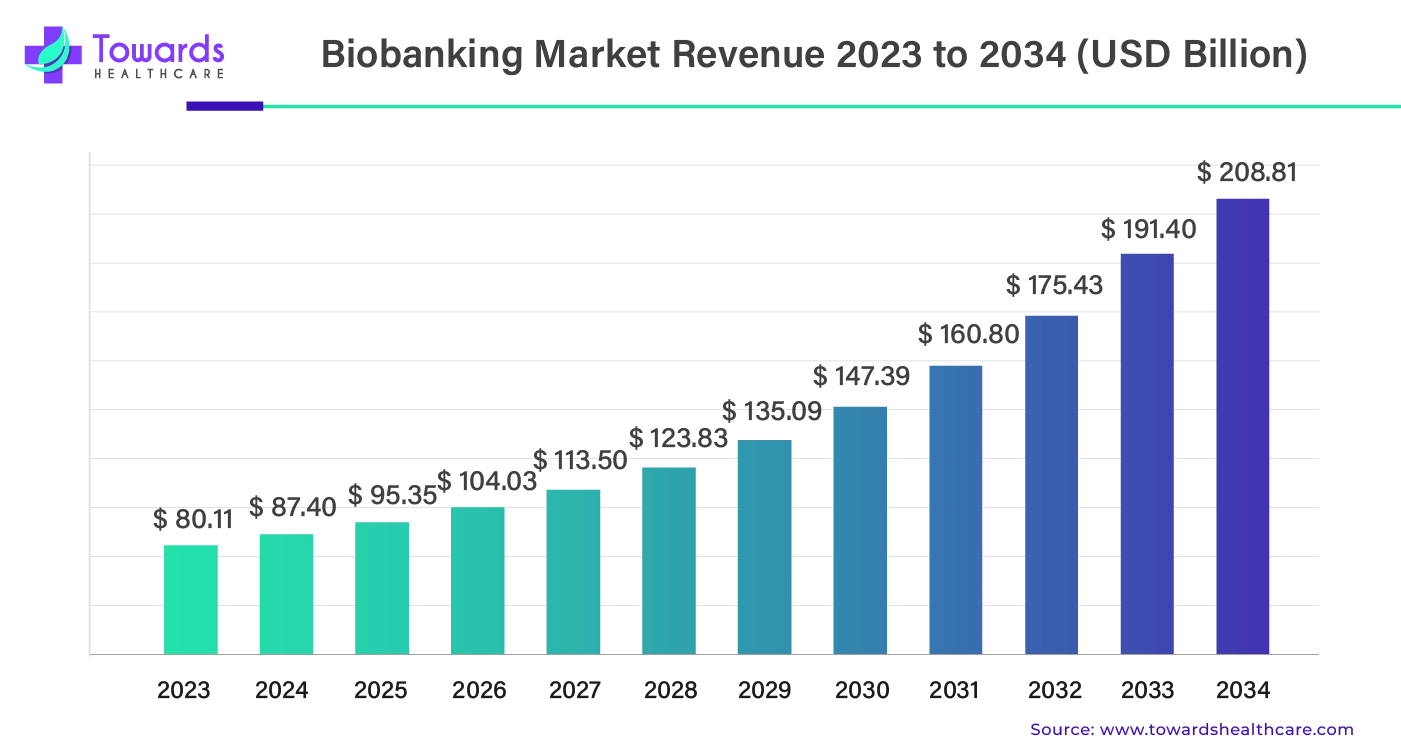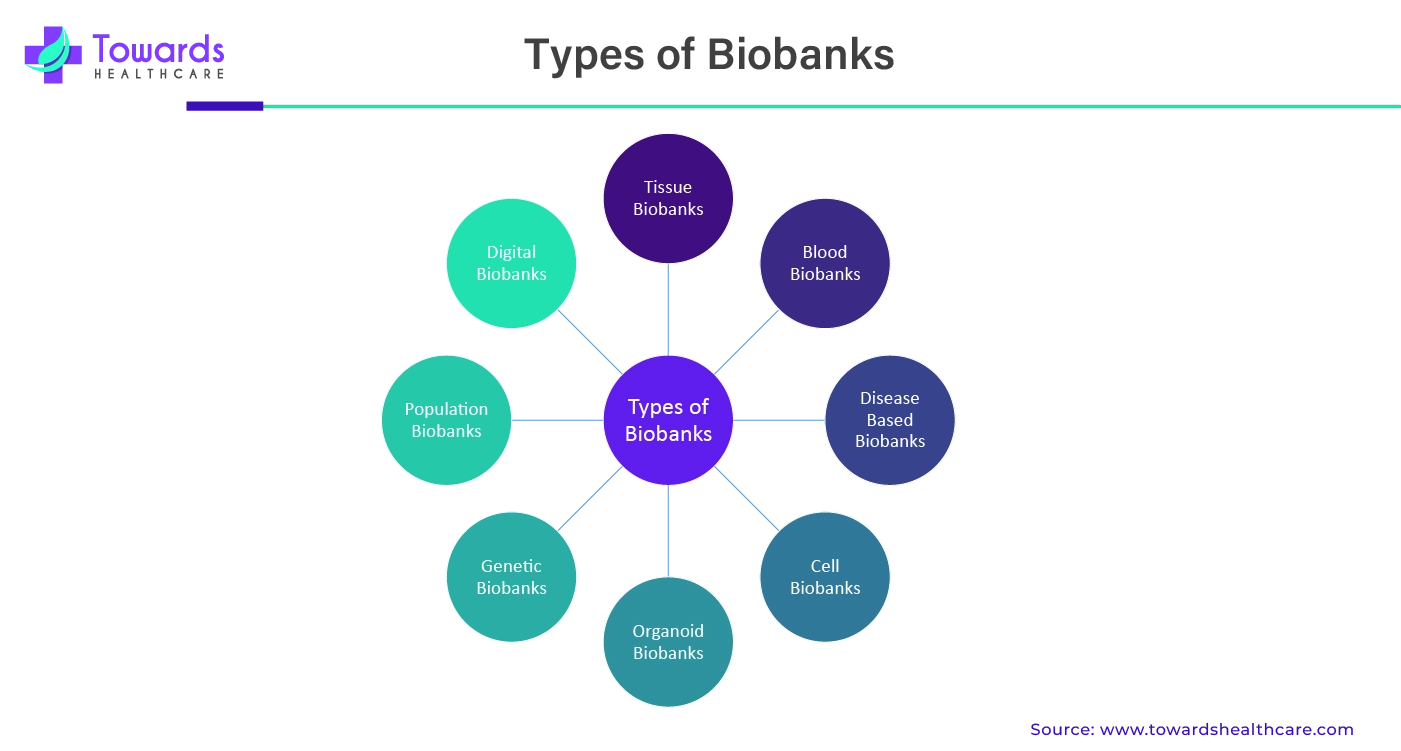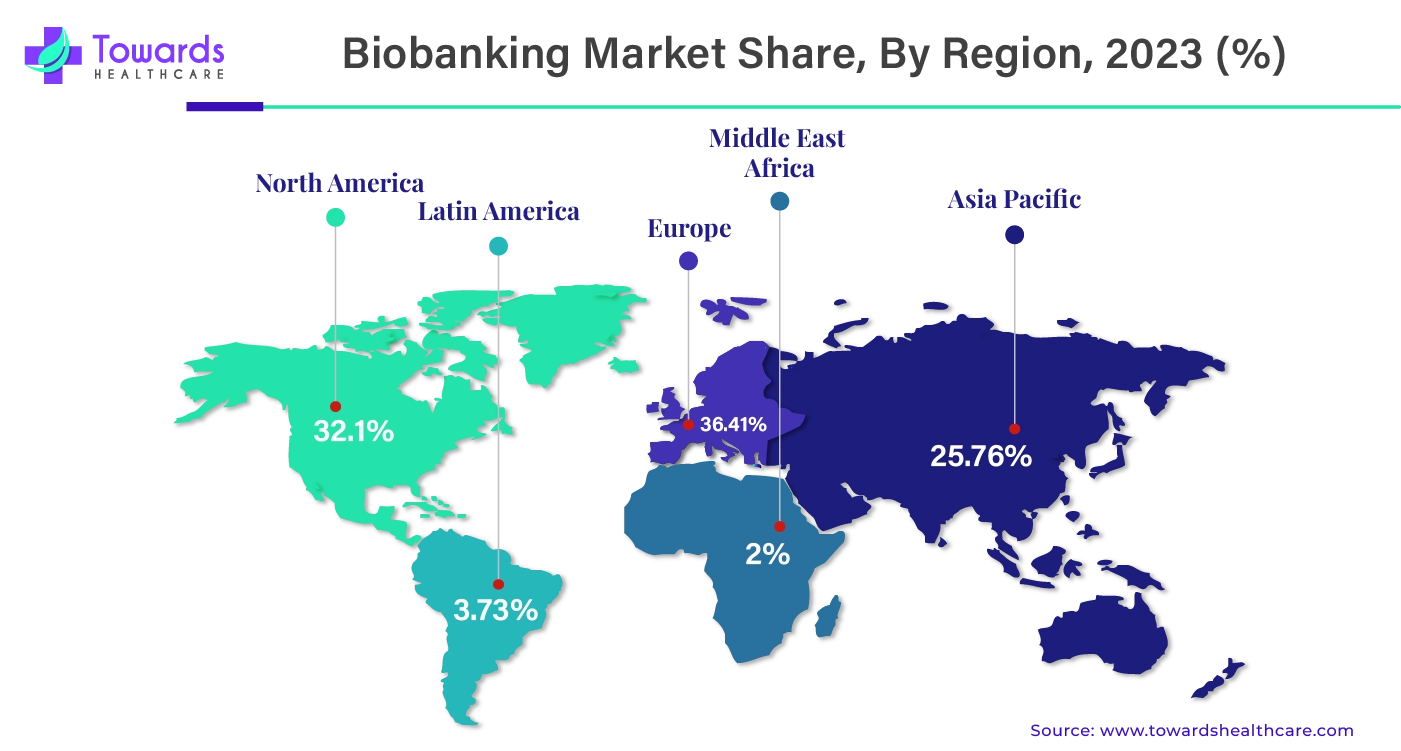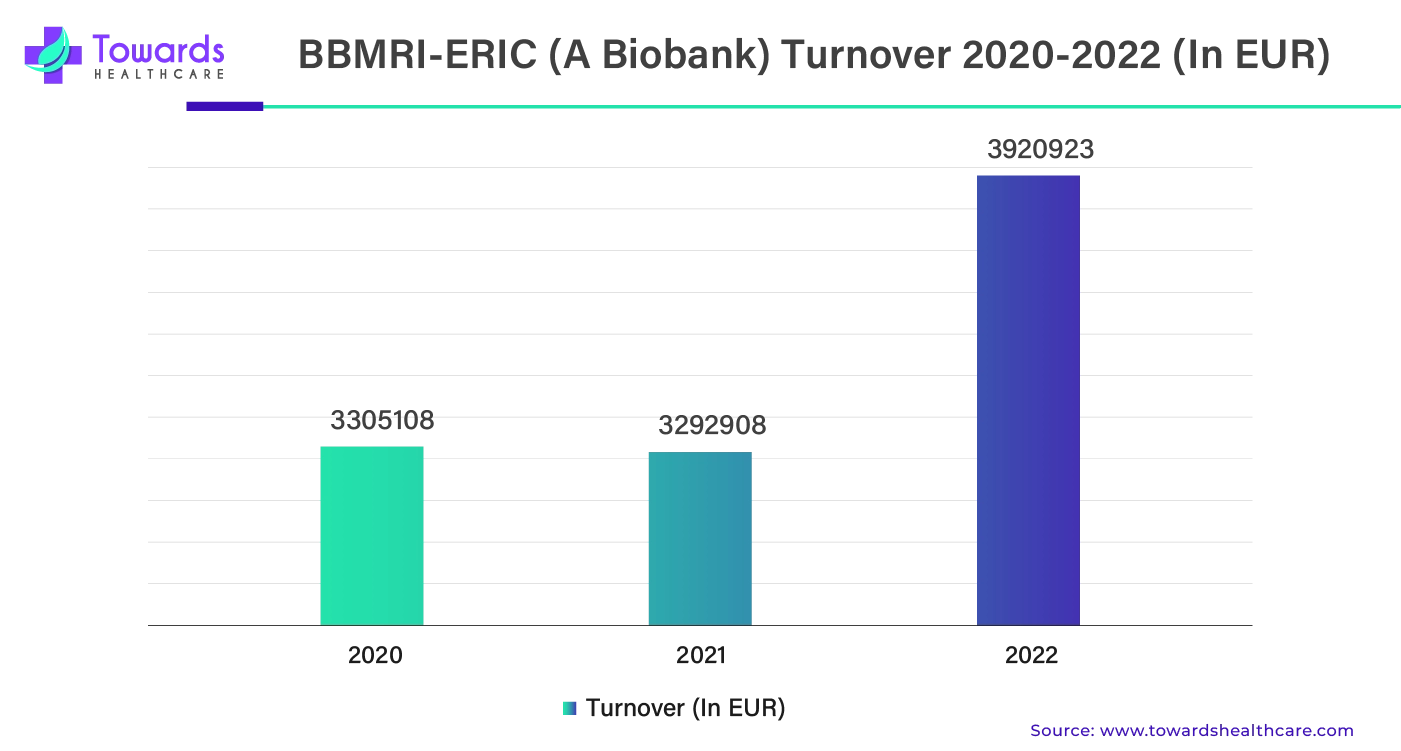December 2025

The global biobanking market size was estimated at US$ 80.11 billion in 2023 and is projected to grow to US$ 208.81 billion by 2034, rising at a compound annual growth rate (CAGR) of 9.1% from 2024 to 2034.

A collection of human biological samples and related data that has been methodically arranged for research purposes is known as a biobank. In response to the shifting requirements of researchers and projects utilizing specimen banking, as well as to external regulatory and associated demands, the area of biorepository and biospecimen science has developed. This shifting environment can be partially ascribed to the increased accuracy of the related scientific domains as well as to new sciences like proteomics, genomics, and customized medicine.
By combining artificial intelligence (AI) with digital pathology, pathology diagnostics that rely on innovative tiny devices may operate more quickly, accurately, and remotely. This facilitates interdisciplinary consultations and supports clinical trials. By identifying novel biomarkers, creating diagnostic plans, and assisting in the choice of targeted treatments, AI deployment in biobanks can ultimately result in more cost-effective and environmentally friendly medical care.
For instance,
High-quality biomedical research requires a well-managed biobank. Due to recent advancements in molecular biology and genetics methods and technologies, the need for adequately maintained, well-annotated specimens has risen. Over the last twelve years, biobanks have been established on numerous continents in response to this need, and others are now under construction.
For instance,
The notion that biobanks are impartial repositories or storage facilities for knowledge seems dubious and supports the breadth of the ethical discussion. The potential ethical problems with biobanking have not received much attention. Research with biobanks raises several special questions with moral ramifications. Multiple researchers and institutions—academic and commercial—may be involved in the sample use process; as a result, everyone involved must adhere to the same ethical guidelines.
Biobanks are remarkable resources for scientific advancement and research. Since their inception, there has been ongoing discussion regarding their primary technological, legal, and moral characteristics. The implementation of common governance and harmonization measures, the need to raise the technical standards for sample collection, conservation, and use, the value of strengthening biobank networks through public-private partnerships, and the sustainability of these infrastructures are all important considerations for the future of biobanks.
For instance,
By product, the biobanking equipment segment held the largest share of the biobanking market in 2023. Biobanks employ various equipment, ranging from simple tools like pipettes to sophisticated and costly machinery like cytometers or sequencers. The equipment management procedure ensures that the Biobank will have the tools necessary to perform its operations if designed and executed correctly. By monitoring them appropriately, it is feasible to guarantee that the devices will operate safely, fulfill requirements, and have a longer service life.
For instance,
By product, the Laboratory Information Management Systems (LIMS) segment is anticipated to grow at the fastest rate in the biobanking market during the forecast period. A LIMS, or Laboratory Information Administration System, is a software program designed to help laboratories with their automation, data administration, and regulatory needs. As the name implies, a LIMS efficiently maintains laboratory samples and the data that goes along with them, standardizing processes through workflow maintenance and automation, test management, and reporting protocols. A LIMS improves the effectiveness, precision, and dependability of laboratory operations, facilitating better decision-making and results.
For instance,
By service, the biobanking & repository segment dominated the biobanking market in 2023. The phrases biobank and biorepository are sometimes used synonymously. They both allude to specialized facilities used to manage and store tissues, blood, DNA, and related information. A biobank or biorepository is almost always maintained by any laboratory that houses a sample storage library. In both situations, these biological sample banks have significant uses in scientific and medical research.
For instance,
By biospecimen type, the human tissues segment dominated the biobanking market in 2023. Human tissues are now being utilized in a wide range of scientific research projects, such as studies on diseases and disorders, including cancer, diabetes, heart disease, Alzheimer's disease, and other dementias, as well as treatments for diseases like multiple sclerosis and Parkinson's. Furthermore, the use of human tissue as biosensors to identify chemical or biological danger ants and in microfluidic systems for toxicological testing is widespread.
For instance,
By biospecimen type, the stem cells segment is expected to grow at the fastest rate in the biobanking market during the predicted period. Stem cells have a potential future in regenerative medicine and aid in natural healing. Stem cell banking, which involves the long-term preservation of various stem cell platforms, is a key means of maintaining the original characteristics of stem cells for use in patient-specific therapeutic applications. The essential and indivisible modules of stem cell research and clinical translation are facilitated by biobanking activities and yield a return on investment.
For instance,

By biobank type, the physical/real biobanks segment held the largest biobanking market share in 2023. Physical biobanks are the places where actual samples are stored and preserved for future use. Such physical banks are equipped with all the necessary equipment, software, kits, and reagents to store the samples properly.
By biobank type, the virtual biobanks segment is estimated to grow at the fastest CAGR in the biobanking market from 2024 to 2033. Virtual biobanks are sizable databases that include high-resolution sample photos and additional descriptive information. Through web portals or specialized software, users may access these virtual biobanks. Samples are kept apart from one another. Access to pre-collected data is possible through virtual biobanks, negating the need for physical sample access. This makes it possible to transmit the sample's data more easily without worrying about contaminating, destroying, or moving the sample.
For instance,
By application, the therapeutics segment held the dominant share of the biobanking market in 2023. The quickly developing discipline of biobanking is now essential to advancing preclinical research and assisting with medication development. Biobanks are repositories that hold substantial collections of biological human materials, such as DNA, blood, and tissue samples. Researchers may access a wide range of biosamples from these archives, which they can utilize to better understand disease causes and patient outcomes.
For instance,
By end-use, the pharmaceutical & biotechnology companies segment dominated the biobanking market in 2023. These companies are involved in various research and development associated with diseases, therapeutics, the functioning of human cells, and so on. All these activities utilize human cells for conducting various experiments, and hence, these companies utilize biobanks for storing samples.

By region, Europe dominated the biobanking market share by 36.41% in 2023. One major factor driving market expansion is the existence of well-established biobanks in European nations such as the United Kingdom, Germany, Denmark, Norway, and Sweden. According to a Global Engage article, almost 40% of Icelanders have given DNA, which is kept in biobanks. Thus, the biobanking sector has expanded as a result of Europe's increasing sample supply. In recent years, the market has grown due to the increasing expenditures made by pharmaceutical firms in research and development, as well as the growing use of virtual biobanking technologies in Europe.
Germany Market Trends
The German Biobank Alliance (GBA) comprises 37 biobank sites in Germany and thus around 95% of the medical faculties. The German Biobank Node (GBN) will integrate into the Network of University Medicine (NUM) from July 2025 to combine the expertise of the biobank community and the German medical research landscape.
UK Market Trends
The UK hosts around 247 biobanks. The UK Biobank is a large-scale biobank database and research resource. The database consists of whole genome sequencing data of 500,000 participants, whole exome sequencing for 470,000 participants, as well as 800,000 genome-wide variants and imputation to 90 million variants.
Transnational research infrastructure projects are becoming an increasingly important component of EU research policy and of European integration in general, even though they existed for a long time before the official integration process that gave rise to the European Union. In recent times, the European Union has formalized scientific collaboration through the Research Infrastructure–European Research Infrastructure Consortium (BBMRI–ERIC), which is an example of institutionalized research collaboration in Europe. European integration and research are anticipated to benefit from BBMRI–ERIC, a network of biobanks across Europe.
| Company Name | BBMRI-ERIC |
| Headquarters | Graz, Austria, Europe |
| Biobanks Connected | 642 (2022) |
| Collections | 3453 (2022) |
| Countries Contributing Collections | 32 (2022) |
| Average Users Per Month | 532 (2022) |
| Total Users | 1178 (2022) |
| Donors in the Federated Platform | 422,576 (2022) |

By region, Asia Pacific is expected to grow at the fastest rate during the forecast period. Asia-Pacific is the biobanking market with the quickest rate of growth due to the region's increased investment in biobanking research and the rising incidence of chronic illnesses. The main cause of this is China's enormous potential. Due to their increased investment in research, China, Japan, and India have been the main drivers of the region's growth in the life sciences sector.
China Market Trends
The China Pharmaceutical Innovation and Research Development Association estimated around 4,441 companies in the pharmaceutical sector. The Chinese government launches various initiatives to strengthen the biotech sector. It focuses on developing new technology and products and accelerating the construction of biotech-specialized high-tech parks.
India Market Trends
Out of 340 biobanks available in the world, India hosts 19 registered biobanks. India is trying to develop more biobanks and also desires an increase in funding for research and establishment. India also reported an increase in biotech start-ups from 50 to over 5,300 in the last ten years. The Union Minister Dr. Jitendra Singh estimated a further increase in biotech startups to over 10,000 by 2025.
NLDB is a first-of-its-kind national biobank, executed as a joint initiative of the Department of Biotechnology (DBT) and the Institute of Liver & Biliary Sciences (ILBS) for translational research in liver and allied diseases. NLDB is the first biobank in India certified by CTR.Net, CANADA, and accredited by ISO 20387:2018.
| National Liver Disease Biobank Data, India (2022) | |
| Bio samples Sharing | 8772 |
| Patients Enrolled | 26855 |
| Sample Aliquots | 185270 |
| No. of NGS Tests | 8198 |
| No. of Mass Spectrometry Tests | 6510 |
| No, of Flow Cytometry Tests | 3526 |
| No. of Animal Pathology Tests | 8291 |
North America is expected to grow at a notable rate in the foreseeable future. The rising prevalence of rare, genetic disorders and the growing demand for precision medicines are the major growth factors of the market in North America. The growing genomics research and increasing investments and collaborations propel market growth. North America and Europe collectively contribute to 95% of all biobanks globally. State-of-the-art research and development facilities and the presence of cutting-edge technologies favor the use of biobanks.
U.S. Market Trends
It is estimated that there are 660 biobanks in the U.S. The U.S. government governs genomics and precision medicine research through initiatives like the “Precision Medicine Initiative” and “All of Us Research Program”. The NIH All of Us Research Program regulates biobanks by collecting blood, urine, and saliva samples.
Canada Market Trends
There are currently 403 registered biobanks, including both Canadian and International biobanks. Statistics Canada biobank is a government biobank that contains biospecimens from over 22,000 Canadians.
| Company Name | EIT Health |
| Headquarters | Munich, Germany, Europe |
| Recent Development | In May 2024, EIT Health introduced a new Biobanks and Health Data Portal. The portal's goal is to promote increased cooperation and use of biobanks—valuable collections of biological samples and related health information. |
| Company Name | Verisense Health |
| Headquarters | Cambridge, U.S., North America |
| Recent Development | In August 2024, the Verisense Digital Biobank, which contains digital health data from over a million individuals representing both particular illnesses and healthy populations, was launched, according to Verisense Health. At present, the Verisense Digital Biobank comprises information from over 570 research projects conducted by Verisense Health as well as other researchers. As of August 2024, the Verisense Digital Biobank has over a million members; the number of business projects will climb to two million by the end of the year. |
By Product
By Service
By Biospecimen Type
By Biobanks Type
By Application
By End-use
By Region
December 2025
November 2025
November 2025
November 2025